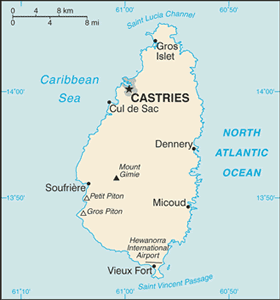The Geography of Saint Lucia
The Geography of Saint Lucia
Saint Lucian Geography
Location: Caribbean, island between the Caribbean Sea and North Atlantic Ocean, north of Trinidad and Tobago
Geographic coordinates: 13 53 N, 60 58 W
Map references: Central America and the Caribbean
Area: total: 616 sq km land: 606 sq km water: 10 sq km
Area - comparative: 3.5 times the size of Washington, DC
Land boundaries: 0 km
Coastline: 158 km
Maritime claims: territorial sea: 12 nm contiguous zone: 24 nm exclusive economic zone: 200 nm continental shelf: 200 nm or to the edge of the continental margin
Climate: tropical, moderated by northeast trade winds; dry season January to April, rainy season May to August
Terrain: volcanic and mountainous with some broad, fertile valleys
Elevation extremes: lowest point: Caribbean Sea 0 m highest point: Mount Gimie 950 m
Natural resources: forests, sandy beaches, minerals (pumice), mineral springs, geothermal potential
Land use: arable land: 6.45% permanent crops: 22.58% other: 70.97% (2005)
Irrigated land: 30 sq km (2003)
Natural hazards: hurricanes; volcanic activity
Environment - current issues: deforestation; soil erosion, particularly in the northern region
Environment - international agreements: party to: Biodiversity, Climate Change, Climate Change-Kyoto Protocol, Desertification, Endangered Species, Environmental Modification, Hazardous Wastes, Law of the Sea, Marine Dumping, Ozone Layer Protection, Ship Pollution, Wetlands, Whaling signed, but not ratified: none of the selected agreements
Geography - note: the twin Pitons (Gros Piton and Petit Piton), striking cone-shaped peaks south of Soufriere, are one of the scenic natural highlights of the Caribbean


